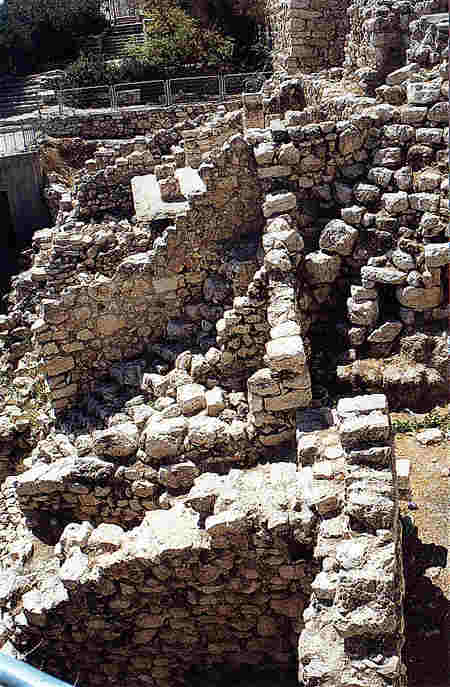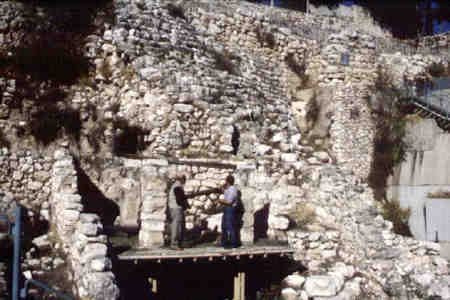|
The City of David
by Jacqueline Schaalje
Many legends are attached to the City of David. The city is the historical site of King David's palace. The narrow ridge, located south-east in the Old City, with the Kidron Valley to its east, is also the oldest part of Jerusalem. The city spread westwards to its current location only after the death of King Solomon.
Jerusalem is first mentioned in Egyptian texts in the 20th century BCE. It was then ruled by a Canaanite people, the Jesubites. Archeologists have found old Canaanite dwellings in the City of David that go back to the 3rd millennium BCE.
According to Joshua 10, Adonitzedek, the Jebusite king of Jerusalem was defeated by the Israelite warrior. But Joshua omitted to conquer the city and it continued as a Jesubite town. Some historians say because Jerusalem was such a small town that it wasn't worth the trouble.
However, when King David was looking for a fit place to build his new capital, he saw its potential. The ridge had its own water resource, the Gihon spring in the Kidron Valley, and the steep valleys on three sides made a natural defense. Moreover, it was unclaimed by any Israelite tribe and thereby clear of the danger of civil strife. Its location was on the border of Judah and northern Israel. The fact that the city was already inhabited, did not trouble David.
Historians still do not know how David took the city, by an organized siege or by lucky stealth. II Samuel 5:6-16 and I Chronicles 11:1-9 tell the story, in which the impression is raised that David's men, Joab first, crept through the city's water system. This may have been Warren's Shaft, called after its 19th century English discoverer. But, in a modern simulation exercise, it was discovered that this channel could only be climbed with the assistance of mountaineering gear!

Working in the City of David
Nor is it known what happened to the original inhabitants. It could be that the Jebusites continued living in Jerusalem, after their initial hostility. This is suggested by the story towards the end of David's life where he buys the threshing floor from his Jebusite subject Arauna (II Samuel 24:18 a.f.) for 50 shekels, so he could erect an altar on it. This place was Mount Moriah (Temple Mount), the same mountain top on which Abraham brought his son, Isaac, as a sacrifice.
As soon as David settled in Jerusalem, he built a palace of wood (the famous Lebanese cedar) and stone (II Samuel 5:11), executed by architects dispatched by the friendly king of Tyre. The palace lay on the crest of the city while the houses stretched down the slope. This enabled David to see Batsheva bathing from the roof of his palace (II Samuel 11:2).
After David's death the city of David lost its prominence. As the number of inhabitants waxed, the city was extended to the west. King Solomon chose to build on the site for the Temple since a promise David had already made ( see II Samuel 7) on the Temple Mount, and he erected his palace adjacent to it.
The city of David continued being a part of Jerusalem and an Iron Age wall was built round it. During the Babylonian conquest of the City of David was fiercely defended (586/7 BCE), which is illustrated by the archaeological finds. According to II Kings 25:9, the Babylonians "burnt the Temple, the Royal Temple and all the houses of Jerusalem."
In later centuries, after the Return from Babylon, the Jewish population had dwindled enough to fit into the City of David again. Their governor Nehemiah got authority from the Persians to rebuild a wall around it (Nehemiah 3:1-32). The population grew during the Hasmonean kings in the second century BCE; they extended Jerusalem again to the west and encompassed the City of David into it. After the Byzantine period apparently the City of David stopped being a part of Jerusalem. Later the Arab village Silwan nibbled at its slope.
Visit
The best view on the City of David is from the Mount of Olives, from the 'Maison d'Abraham.' The City of David is inaccessible by car. Two footpaths lead to down, one from the parking lot on the north-west, outside Dung Gate to the Old City. The second path leaves from the Temple Mount's south-east corner.
The excavation area on the north shows the acropolis from the time of King David. From the north the site is approached by a stepped ramp, or glacis, built by David shortly after he conquered the city. Its purpose was to defend it and also to create a base for his palace. The two holes in the middle of the ramp may have been drains.
This was also the site of the Jebusite palace. But only the thin Jebusite sustaining walls, running west-east, are still standing. The space in between was filled in with rubble, thus creating a base for the palace on top of it.
In between the ramp and the Jebusite walls, the remains of buildings are not of David's palace, but later Israelite houses. They were destroyed during the Babylonian invasion of Jerusalem. The most northern dwelling is called the burnt room (with an outside staircase). Inside numerous arrow heads were found in the charred debris.
The house in the middle is the house of Ahiel, called after a pottery shard with this name on it. This typical Israelite house has four rooms and was partly dug into the glacis. There are two stumps of columns which supported the roof. The outside stairs would have led to the roof. On the right (north) is a small room with a 2 m deep pit and a stone with a hole placed above it; presumably a toilet.

Working in the City of David
On the east is the bullae house, so called because 50 stamps with ancient Hebrew lettering were discovered. They were made of clay and were used to lock a papyrus roll. Each seal bears a personal name. Two of them are biblical: Gemaryahu son of Shafan, a scribe at the court of King Jehoiakim, who reigned in Jerusalem during the Babylonian attack (Jeremiah 36:10), and Azaryahu son of Hilkiyahu, a member of the family of high priests who served in the Temple (1 Chronicles 9:10). Because the seals were found in an ash layer, they were preserved.
The wall of Nehemia, the first one to be built on top of the hill, has not been found, but archeologists believe that it lies under the thick Hasmonean wall, to the west of the acropolis. To the north and south of the acropolis are Hasmonean towers.
Jerusalem's waterways
From the acropolis the path goes down to Warren's Shaft. This is a tunnel leading to the Gihon Spring. Not meant for climbing down - the steps are modern - water was hailed by a bucket on a rope down to the spring-fed pool. The tunnel is natural: made by a natural fissure in the rock, it was enlarged by the Jebusites. The shaft gave them ideal water access in case of sieges. The entrance to the tunnel was within the Jebusite city wall which was lower down on the hill.
A long way down in the tunnel there is a hole on the left, which gives access to Jerusalem's oldest walls. The outer one is the Jebusite wall dated to the 18th century BCE. It has very big rough stones and is exposed 40 meters. In peacetime there would have been a gate to the Gihon spring just outside of the wall.
The second wall is Israelite from the 8th century BCE. It served until the Babylonian invasion and can be followed 100 meters to the south. In some places there are houses which were destroyed by the Babylonians. The inner wall is a modern retaining wall.
The Gihon Spring ('gihon' means gushing) is perennial but trickles slowly and could not support the growing population of Solomon's capital. That's why he built another tunnel along the bottom of the hill from the spring to Siloam's Pool. It can be seen more south in the city of David in the excavation of the Hasmonean tower. The tunnel was sometimes pierced to let water irrigate the King's Garden in the Kidron Valley (II Kings 25:4).
Later King Hezekiah (727-698 BCE) realized Solomon's tunnel was not safe. The Assyrian king Sennacherib had already invaded Judah and Hezekiah expected a siege on Jerusalem. He dug another tunnel, after having cut off the water from the Gihon spring (because the spring was outside the city wall) (II Chronicles 32 and II Kings 20:20). Hezekiah's tunnel is connected to Warrens' Shaft. It can be entered from the Gihon Spring. Visiting is not dangerous but good footwear and a flashlight are indispensable. The water is usually at an adult's hip level.
Near the Pool of Siloam, 10 m from the entrance at its other end, an inscription by Hezekiah's engineer was found which is now in the Istanbul Museum. It describes that two teams of diggers began digging at each side and met in the center. Here is how they did it: "Behold the tunnel. This is the story of its cutting. While the miners swung their picks, one towards the other, and when there remained only 3 cubits to cut, the voices of one calling his fellow was heard - so there was a resonance in the rock coming from both north and south. So the day they broke through the miners struck, one against the other, pick against pick, and the water flowed from the spring towards the pool, 1200 cubits. The height of the rock above the head of the miners was 100 cubits."
Note that King Hezekiah is not mentioned. But the inscription, in ancient Hebrew, was dated to his time.
Hezekiah's tunnel is curvy and measures 538 meters. It ended in a large pool called Birket al Hamra, which is today planted with fig trees. Next to it is the Pool of Siloam, but it is not in its original shape anymore. This was destroyed by the Romans in the First Jewish War, who "burnt the whole place as far as Siloam (Josephus Flavius, War 6:363)." The current rectangular was built in the 19th century. The water was said to be healing, and this inspired building a church and later a mosque.
From the southern end of the Iron Age wall one can climb to two large shafts. These are believed to be the burial tombs of the kings of Judah. In one recent book a historian believes that the (lost) tomb of David is to be found here, including many treasures which lie deeply buried. In reality, nothing has been found so far. The Bible does say that David was buried in the City of David (I Kings 2:10). The rock was worked as a quarry in ancient times, which is clearly visible. The burial shafts are indeed graves but compared to the tombs in the Kidron Valley they don't look royal.
~~~~~~~
from the October 2002 Edition of the Jewish Magazine
|











